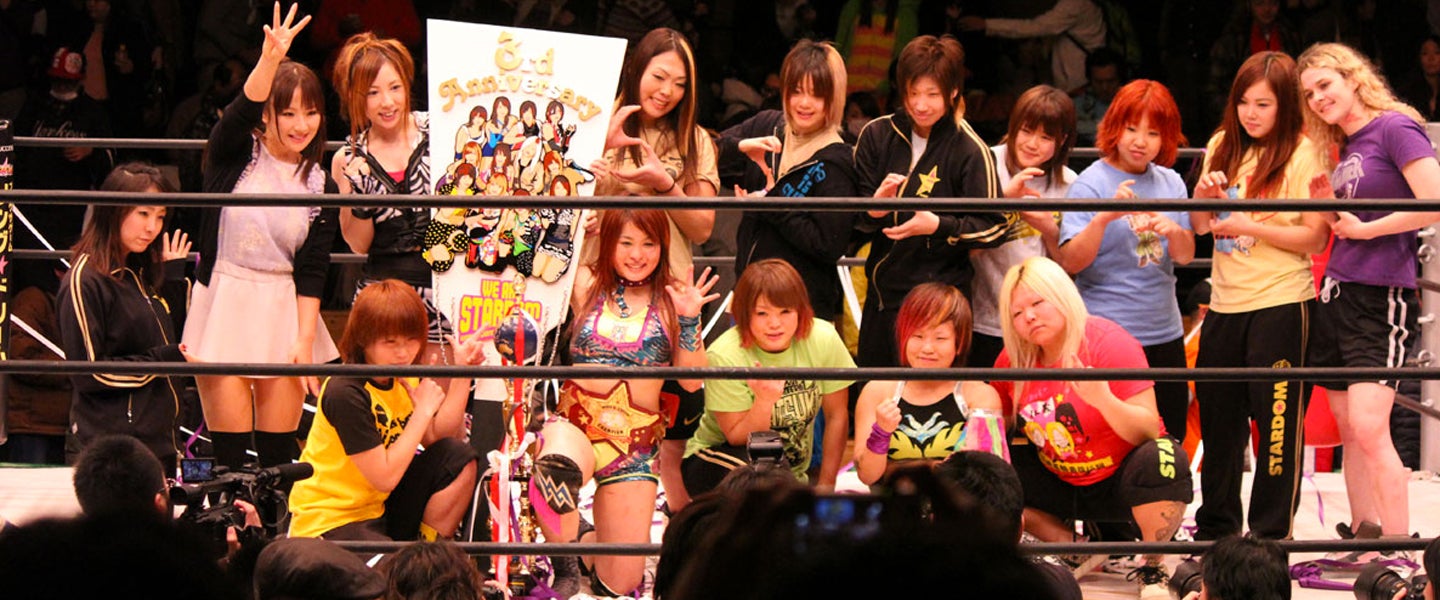Recently, more as a social media topic than anything else, there’s been a fierce argument among hardcore fans of professional wrestling: Should New Japan Pro-Wrestling (NJPW), the number two promotion in the world behind WWE, add a women’s division?
If you’re a casual wrestling fan, or even a newer hardcore fan, the answer seems like a “yes.” After all, every other pro wrestling company on the planet that can be described as a major promotion has a women’s division — from WWE, to Sinclair Broadcasting’s Ring of Honor, to Mexico’s AAA and CMLL, to British TV-only startup World of Sport Wrestling, to the smaller televised U.S. promotions like Impact Wrestling. On top of that, NJPW’s training system produces a higher baseline of talent than just about any other, and there are also plenty of high-level female wrestlers in Japan working for smaller promotions. Plus, with NJPW being the only Japanese promotion doing the amount of business it does, the only one with network television (albeit late at night) and the only one looking to expand internationally, there are certainly reasons to think that it would be a positive step.
But the reality is a good bit more complicated than that, with Japan’s wrestling history largely separated into distinct men’s and women’s promotions.
This goes back to when pioneering female wrestler and trainer Mildred Burke first brought a troupe of women over in 1954. Those tours and smaller circuits paved the way for a major promotion, All Japan Women’s Pro-Wrestling (AJW), which formed in 1968 and got broadcast network television on Fuji TV. In the early years, business wasn’t great, and neither was the in-ring wrestling, which wasn’t much better than that of the mundane, overly basic and hair-pulling style of contemporaneous American women’s champion/promoter Fabulous Moolah.
That started changing in the mid-1970s, though, when the Matsunaga brothers, who owned the company, unveiled a new lead tag team: Jackie Sato and Maki Ueda as the Beauty Pair, a singing tandem of teen idols. While they were markedly better performers in the ring than their predecessors — as well as a lot of their male contemporaries — the company being built around idol singers sent a message to the general public: With teen idols on top, women’s wrestling was to be viewed as something akin to junk entertainment for tween and teen girls.
Still: “Many women are attracted by the sight of women who can fight this way,” Beauty Pair manager Kenichi Aizawa told the Honolulu Advertiser in 1978. “Many young male stars are effeminate and so young girls are turning to strong women. We often hear girls saying that boys are too weak. This is why they love Beauty Pair.”
Miyuki Hashimo, a 14-year-old fan, more or less echoed that sentiment, saying, “I love Beauty Pair because they are stylish,” and “They’re strong, like men.”
A few years after the Beauty Pair retired, AJW put together another team of stylishly butch idols, the Crush Gals, comprised of Chigusa Nagayo and Lioness Asuka, who were even more successful, to the point of landing a Wall Street Journal profile. (They also benefited from superior foils, Dump Matsumoto and her Gokuaku Domei, or “Atrocious Alliance.”) But in the late 1980s, when AJW’s mandatory retirement age of 26 took the Crush Gals away, much of the audience went with them.
Today, the premier women’s promotion in Japan is World Wonder Ring Stardom (commonly “Stardom”), formed in 2010 by former AJW matchmaker Hiroshi “Rossy” Ogawa. It’s not an AJW-size company, though; in fact, nobody’s come close to that kind of success with women’s wrestling in Japan since the incumbent lost TV in 2002 and closed in 2005. (Chigusa Nagayo’s company, GAEA Japan, which took over as the top women’s promotion in the early 2000s, closed the same year that AJW did.) During AJW’s various boom periods, they benefited from not just network TV exposure, but also a sports media that embraced wrestling in various magazines and newspapers. In 2019, however, only NJPW has network TV in a country that’s largely allergic to paying for cable and satellite services, and print media is, well, print media.
As a result, the other, newer promotions — including all women’s groups — arguably have something of a hard ceiling. According to Sonny Gutierrez, an American expat who works as Stardom’s foreign talent relations director, the company is growing and drew about 38,000 fans in 2018. But when NJPW can draw about the same number to just one card, the latest Wrestle Kingdom event at the Tokyo Dome, it sends a message to the Western fans that they’re trying to win over: NJPW is the only path to real money and exposure in Japanese wrestling.
Utami Hayashishita made her debut earlier today at Korakuen Hall versus Jungle Kyona, and you can watch it now on https://t.co/q8dHnF58vW! pic.twitter.com/QOgjd9EEZN
— We Are Stardom (@we_are_stardom) August 12, 2018
Gutierrez, however, believes that the world is changing enough that, with easy internet-based access to other promotions — as opposed to requiring a cable or satellite subscription — that there’s plenty of room to grow. In addition, there’s still room for Stardom to get exposure in mainstream outlets that the general public will pay attention to. Even in the changing media space, the annual wrestling awards from the daily newspaper Tokyo Sports, for example, have decades of tradition and gravitas behind them. Gutierrez argues then that Stardom winning some of the awards, like Utami Hayashishita winning the gender-neutral Rookie of the Year category over wrestlers from bigger promotions, brings new awareness to the company.
“It’s not 1987 and women’s wrestling isn’t on in the golden hour like it was for the Crush Girls, but that doesn’t mean we can’t be successful,” he notes. He adds that “merchandise sales are fantastic” and the decision to gear the Stardom World streaming service toward the West, with English subtitles for all interviews — a rarity in wrestling — has paid off. “We aren’t running the Tokyo Dome, but we’re doing better than we ever have.” Especially notable is that Stardom’s New York City debut, set for WrestleMania weekend in April, almost immediately broke even, despite the fact that it was announced weeks after other independent shows running simultaneously had put their tickets on sale.
“This is the tradition of pro wrestling in Japan,” Stardom promoter Ogawa tells me. “For over 60 years, men’s companies have been around. For 50 years, women have had their own companies, their own shows and have excelled. Sometimes a group will have men and women together, like FMW, but women were traditionally separate.”
FMW, short for Frontier Martial-Arts Wrestling, was a ragtag group of misfits, built largely around wrestlers who had been shunned by other companies due to injuries, politics and who knows what else. That applied to not just the men, but also the women’s division, with several of the distaff performers, like Megumi Kudo, having been accepted into and trained by the AJW dojo, only to be cut as rookies due to its absurdly high in-ring standards.
Those circumstances aren’t really going to repeat themselves in 2019, when the biggest Japanese company to maintain rosters of both sexes is Dramatic Dream Team, or DDT. The Little Engine That Could of Japanese wrestling, DDT has grown in the last 15 years from a tiny Japanese indie promotion with a nearly invisible satellite TV presence to the top indie in the world, before eventually being bought by new corporate overlords. Throughout all of this, it developed the best recruiting pipeline in Japan, to the point that it even has multiple sub-promotions, including Tokyo Joshi Pro, an all-women’s group, and a separate women’s dojo. However, DDT’s integration of female talent is, like with FMW, very unique to the DNA of that specific company.
See, DDT has long been the Japanese promotion that embraces American-style “entertainment wrestling” most strongly and takes that influence comically far. (To Americans, it’s probably best known as where Joey Ryan first used his penis to win a test of strength.) That U.S. influence is something that company founder Sanshiro Takagi agreed, in a Twitter DM to me, was a big factor in DDT fully embracing women’s wrestling. And like DDT being more “Western” helped bring women into the company, Stardom’s Ogawa does see the merit in NJPW possibly needing to diversify while expanding westward. “If New Japan stays abroad, they may feel compelled to add women, such as working with ROH’s women,” he said. “But in Japan, it isn’t necessary.”
Even if the management of the biggest women’s company thinks they’re growing just fine on their own, and the fans fear that an NJPW women’s division would result in Stardom and other women’s groups being picked over and left for dead, there’s still a lingering question: Wouldn’t women being featured in NJPW, even from a relationship with a women’s group, still get more eyeballs and new fans than the status quo? After all, NJPW has a pretty heavily female audience — certainly more so than most men’s wrestling promotions.
Rossy doesn’t think so. In fact, he says it’s the opposite of the AJW heyday. “In today’s Japan market, women do not pay to see women,” he claims.
With such an entrenched belief, there might never be an opportunity to prove otherwise.

